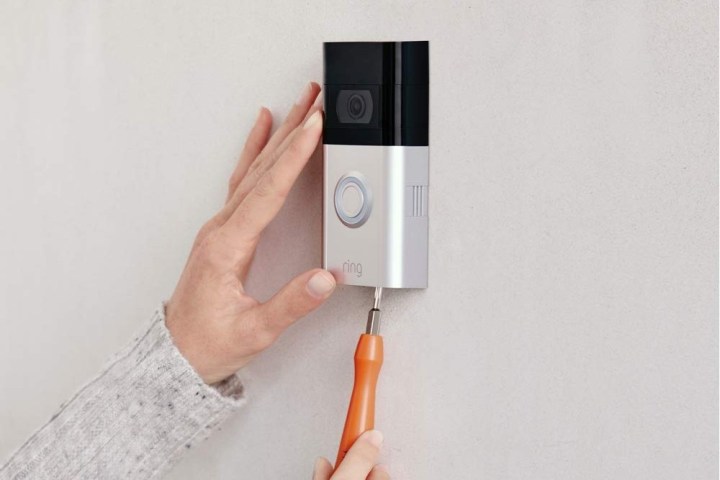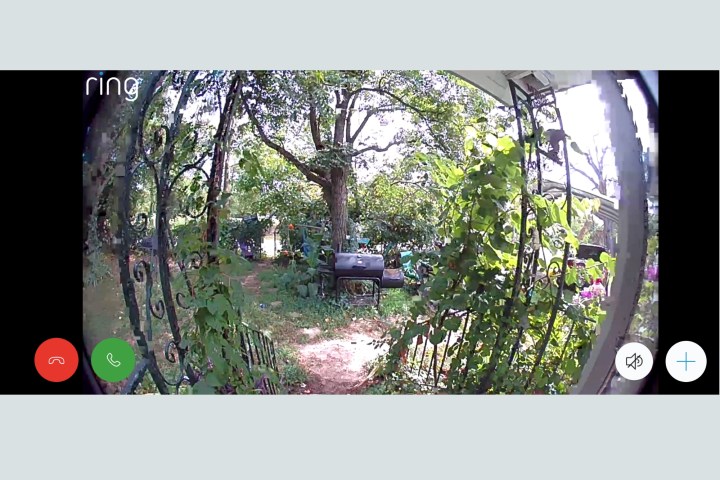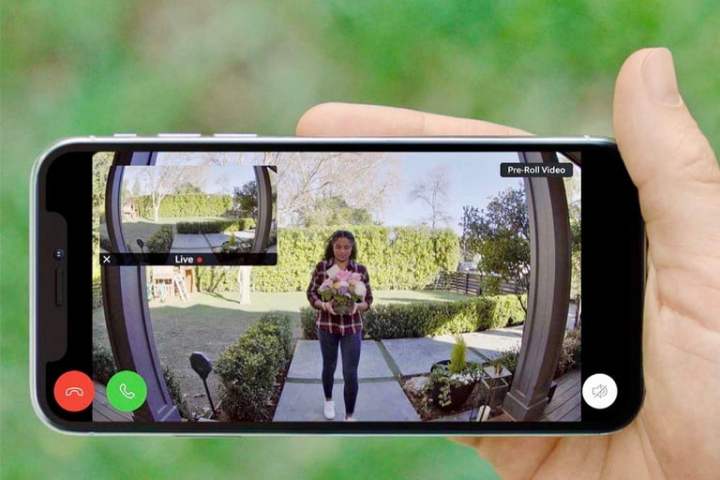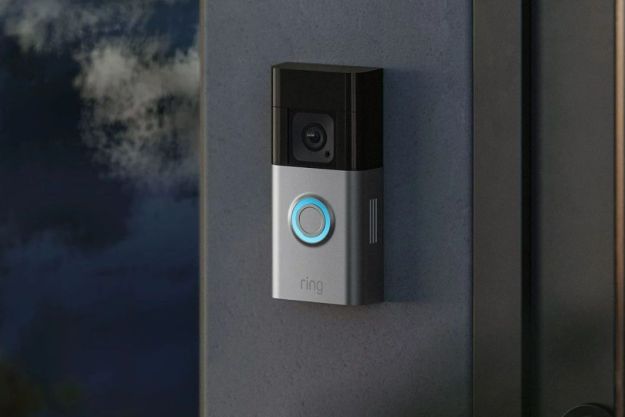Equipping your home with a video doorbell can provide convenience and peace of mind. You can lounge on the couch, hear your bell chime, ask your compatible Echo Show who’s at the door, and then be greeted by real-time footage of your guest on your smart display. As one of the leading brands in the video doorbell marketplace, Ring has struck again with the release of its latest hardware — the Ring Video Doorbell 4.
Engineered around the same app and interface that existing Ring owners will be familiar with and new users can quickly adapt to, the company’s latest video doorbell offers a few new features and a competitive price. But does it make more sense to hang onto your existing Ring Video Doorbell 3 instead of upgrading? In this comparison, we pit both bells against each other, weighing in on criteria like design, features, and overall value. Read on to see which Ring bell we want hanging by our own front doors.
Design

Aesthetically, there’s not much difference between the Video Doorbell 4 and 3. Both products measure 5.1 inches wide, 2.4 inches tall, and 1.1 inches deep, keeping with Ring’s long-running generational design for its battery-powered video doorbells. Out of the box, both bells come with a rechargeable battery pack, USB cable, installation hardware, corner wedge kits for bumping the bell out past exterior home obstructions, and a satin nickel faceplate. After activating the doorbell, you’ll be emailed a voucher for a second faceplate at no cost. Additional colors include green, orange, purple, and several others.
In terms of weathering the great Mother Nature, both bells are capable of withstanding temperatures between minus 5 degrees and 120 degrees along with contact from precipitation.
As there’s nothing to set both bells apart for overall physical design, we’re awarding laurels to both.
Winner: Tie
Installation process

Here’s another category that’ll see more similarities than differences between both products. Both the Video Doorbell 4 and 3 are part of Ring’s battery-powered lineup of doorbells. If you’re using the battery pack (instead of existing doorbell wiring) the install process is relatively straightforward, and both bells come with everything you need to get the ball rolling. All one has to do is mount the bell (with optional corner wedging when needed), put in the battery, snap the faceplate in place, then connect the bell to your home Wi-Fi.
If you’re negating the battery experience altogether, both bells also have the capability of being hard-wired to your home’s existing doorbell system. Must-have specifications for your connections are 8-24 VAC, 40VA max, and 50/60Hz. In cases where there’s not enough juice, you can purchase a Ring plug-in adapter instead.
While there’s not much to set either bell apart from the other, we’re giving a laurel to the Video Doorbell 4 in this category. Thanks to improved Wi-Fi connectivity and performance over the Video Doorbell 3, users can expect quicker pairing and responsivity from Ring’s latest hardware.
Winner: Ring Video Doorbell 4
Image quality

While both the Video Doorbell 4 and 3 capture and display footage in full 1080p HD along a 160-degree horizontal axis and 84-degree vertical axis, the Video Doorbell 4 has a leg up over its older brother in the image quality department. This is thanks to the camera’s Pre-Roll feature, a feature introduced with the Ring Video Doorbell 3 Plus. When a motion event is triggered, the Ring bell will capture up to four seconds of video before the motion trigger occurred, netting you vital details about who exactly is on your property and when.

While the 3 Plus was the first battery-powered Ring cam to support the feature (the Video Doorbell 3 doesn’t offer Pre-Roll at all), the 3 Plus only records Pre-Roll video in black and white and at a much lower resolution than 1080p. With the Video Doorbell 4, the four-second Pre-Roll function gets a colorized, high-res makeover, displaying Pre-Roll footage in full color and at a resolution much closer to 720p. It’s not Full HD, but it’s better than the grainy captures of the 3 Plus.
When it comes to image quality, the more detail the better. Thus, we award the Video Doorbell 4.
Winner: Ring Video Doorbell 4
Features

The Video Doorbell 4 and 3 offer a number of the same key features along with a few standalone functions that you’ll only find with Ring’s newest hardware. For starters, both bells allow users to create customized motion zones using the Ring app, with built-in motion alerts for when a subject crosses the perimeter(s) you’ve created. Additionally, real-time video in Full HD is available at any time by simply opening the Ring app and selecting the doorbell you want to view footage from. If you’re running an Alexa-powered smart home and own a smart display, you can view live footage on your Echo Show or other compatible devices with voice commands like “Alexa, talk to the front door.” In this scenario, you’d be shown live video from your front door cam with the option of communicating with your visitor through the doorbell’s two-way audio feature (available for both models).
In terms of Wi-Fi performance, the Video Doorbell 4 promises enhanced connectivity. While both bells are capable of 2.4GHz and 5GHz connections, the Doorbell 4 should deliver sharper live and recorded video, faster response time when using the Ring app, and longer battery life. Speaking of battery, Ring’s latest hardware also promises better battery health overall. While exactly how long the battery lasts depends on things like how often the doorbell is triggered and the environment, Ring claims that users can expect stronger results compared to even the 3 Plus, 2020’s minor upgrade to the Doorbell 3.
While not a deal breaker, the Doorbell 4 also supports Ring’s Quick Replies feature. When enabled, you can choose from six different voice responses that will be triggered when someone rings the bell. Visitors themselves can then leave a message for you to hear at a later time. Not one to be left in the dust with this useful feature, Ring is currently rolling Quick Replies out to the Doorbell 3 as well.
With slight advantages here and there, along with the aforementioned colorized Pre-Roll addition, we’re giving the features trophy to the Doorbell 4.
Winner: Ring Video Doorbell 4
Price, warranty, and subscriptions
The Ring Video Doorbell 4 sells for $200 and includes a one-year limited warranty. The Ring Video Doorbell 3 currently sells for $180 (with the same one-year limited warranty), a price point we’re assuming will drop as the Doorbell 4 stays on the market for a while.
If you want to unlock even more Ring capabilities, you can subscribe to a Ring Protect plan. Starting at $3 per month (or $30 per year) for one Ring device, a basic Protect plan allows for up to 60 days of recording storage, Snapshot capture, special notification features, and more. For $10 per month (or $100 per year), users can opt for a Ring Protect Plus plan, with additional benefits including Alexa Guard Plus, 24/7 monitoring if you have a Ring Alarm, and an extended warranty. Best of all: With Ring Protect Plus, the plan adds these benefits to every Ring device on your home’s network.
The verdict

Security is key when it comes to a top-notch video doorbell. While the Ring Video Doorbell 3 is still an amazing bell with plenty of great features, the Ring Video Doorbell 4 turns things up a notch in a few crucial ways — specifically, with colorized Pre-Roll and enhanced Wi-Fi and battery — and for just a few dollars more than the older generation.
In a nutshell: If we’re the ones spending the money, we’re going with the Ring Video Doorbell 4 as our Ring product of choice.
Editors' Recommendations
- Blink Mini 2 vs. Ring Stick Up Cam Pro: Which is the best security camera?
- Ring Battery Doorbell Pro vs. Aqara G4: Which is the better video doorbell?
- Best Ring deals: Save on Ring doorbell and Ring alarm bundles
- How to install a Ring Video Doorbell at your home or office
- Do you need a subscription for a Ring doorbell or camera?



